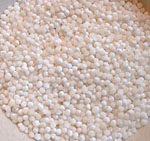 In 1860 the ruler of Travancore introduced tapioca sago or cassava i.e. sabudana in India. Now cultivated on about 3 lakh hectares, India produces 58-60 lakh In 1860 the ruler of Travancore introduced tapioca sago or cassava i.e. sabudana in India. Now cultivated on about 3 lakh hectares, India produces 58-60 lakh
tonnes annually. Kerala grows the most, but Tamil Nadu processes as much as 40 lakh tonnes. Hundreds of small-scale industries situated in Salem manufacture sago globules or pearls.
The sago crop has a 10-month cycle to maturity. A large number of people in North and West India consume it. But, farmers say that one of the reasons consumers have begun eating oats instead, is the extensive use of pesticides utilised by business groups to process sago and because cassava starch is allowed to be imported from Thailand, Indonesia and Vietnam. (It is consumed as noodles in those countries.)
Tapioca sago globules are called sabudana in Hindi, Gujarati and Marathi, shabudana in Bengali, sabakki in Kannada, saggu biyym in Telagu, maracheeni in Malayalam and javvarishi in Tamil.
Sago can also be derived from the pith of various tropical palm trees like the sago palm, whereas tapioca sago (that we are covering here) comes from the cassava plant which is a woody shrub. Sago pearls are typically larger and translucent with a glossy white appearance and they’re also softer and tender than tapioca.
Roasted sago is known as sago common, and boiled sago as nylon sago. Moti sago and pearl sago are also marketed. When soaked in water the sago globules become soft and spongy, but turn translucent when cooked.
Misleadingly Pure Veg
Sago is usually cultivated in India without pesticides, but more often than not, during production insects are responsible for making it lose its vegetarian-ness.
Upon harvesting, the tuber roots are peeled, washed, pulped and are required to be soaked in shallow pools of water for up to 3-4 days to make the roots soften and break down the linamarin enzyme to make it harmless. At night thousands of insects are attracted to this water, fall into the tanks and die. It turns unhygienic despite operations being carried out by machines.
In many factories children crush the mass by jumping up and down in this dirty, muddy water. Floating impurities are drained after eight hours (the process is called dewatering) and the sediment (called milk cake) is processed into globules which are roasted, boiled or steamed, following which they are dried directly under the hot sun.
Whitening agents for bleaching (calcium hypochlorite, sodium, hypochlorite, etc.) and acids (sulphuric, phosphoric, etc.) may also be added. Some manufacturers have been caught using optical brighteners like “2-B-Con” or Tinopal which are hazardous to health. Some other manufacturers have been caught adulterating sago with sand and talcum.
In fact, optical whitener and sulphuric acid are said to be widely used. In October 2013, six of the nine samples tested by the Food Safety and Standards Authority of India (FSSAI) were found to be adulterated and unsafe for consumption.
In August 2019 the Federation of Tamil Nadu Agriculturalist Associations urged the state government to take action against those involved in adulteration of sago with calcium hydrochloride, sodium hydrochloride and maize flour to make starch appear white. They went on to say that tapioca was introduced in India by the Portuguese as the crop requires less water. If adulteration continued the consumption would fall and tapioca farmers would lose their livelihood.
Again in 2021 as much as 13 tonnes of sago products adulterated with chemicals were seized at a sago manufacturing unit near Thalaivasal near Coimbatore. And in 2022 December, 5,445 kgs of adulterated javvarishi was seized in Trichy.
Consumption and Many Other Uses
Sago is full of starch (carbohydrates) and since it boosts energy, it has for generations been eaten during periods of religious fasting or vrat. Unfortunately, sabudana has mistakenly been considered pure enough for consumption during this time.
Preparations include khichadi, vada, papad, chiwda, khir/payasam, upma, fariyali, chowwary and chips (like potato wafers). Sago flour is also utilised in many other preparations including cakes.
Kumkum, applied to the forehead, or used for religious purposes, is sometimes made from the same sago powdery starch mixed with coal tar colours of mineral origin.
In fact, sago starch is widely utilised by the paper, plywood and textile industries, for the manufacture adhesives and biodegradable plastic, monosodium glutamate, high fructose glucose syrups, animal feed, and much more.
|